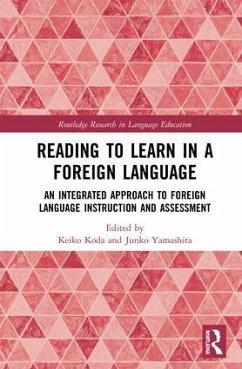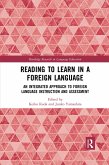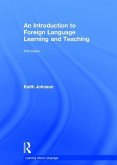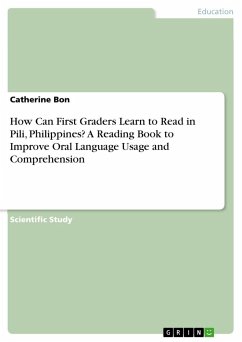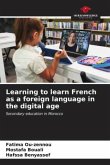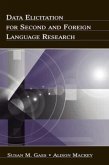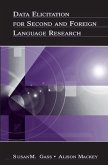Reading to Learn in a Foreign Language
An Integrated Approach to Foreign Language Instruction and Assessment
Herausgeber: Koda, Keiko; Yamashita, Junko
Reading to Learn in a Foreign Language
An Integrated Approach to Foreign Language Instruction and Assessment
Herausgeber: Koda, Keiko; Yamashita, Junko
- Gebundenes Buch
- Merkliste
- Auf die Merkliste
- Bewerten Bewerten
- Teilen
- Produkt teilen
- Produkterinnerung
- Produkterinnerung
This book describes a theory-guided approach to Foreign Language (FL) course development, implementation, instruction and assessment.
Andere Kunden interessierten sich auch für
![Reading to Learn in a Foreign Language Reading to Learn in a Foreign Language]() Reading to Learn in a Foreign Language55,99 €
Reading to Learn in a Foreign Language55,99 €![An Introduction to Foreign Language Learning and Teaching An Introduction to Foreign Language Learning and Teaching]() Keith JohnsonAn Introduction to Foreign Language Learning and Teaching164,99 €
Keith JohnsonAn Introduction to Foreign Language Learning and Teaching164,99 €![How Can First Graders Learn to Read in Pili, Philippines? A Reading Book to Improve Oral Language Usage and Comprehension How Can First Graders Learn to Read in Pili, Philippines? A Reading Book to Improve Oral Language Usage and Comprehension]() Catherine BonHow Can First Graders Learn to Read in Pili, Philippines? A Reading Book to Improve Oral Language Usage and Comprehension17,95 €
Catherine BonHow Can First Graders Learn to Read in Pili, Philippines? A Reading Book to Improve Oral Language Usage and Comprehension17,95 €![Learning to learn French as a foreign language in the digital age Learning to learn French as a foreign language in the digital age]() Fatima Ou-zennouLearning to learn French as a foreign language in the digital age29,99 €
Fatima Ou-zennouLearning to learn French as a foreign language in the digital age29,99 €![Data Elicitation for Second and Foreign Language Research Data Elicitation for Second and Foreign Language Research]() Susan M. GassData Elicitation for Second and Foreign Language Research55,99 €
Susan M. GassData Elicitation for Second and Foreign Language Research55,99 €![English as a Foreign Language in Saudi Arabia English as a Foreign Language in Saudi Arabia]() English as a Foreign Language in Saudi Arabia54,99 €
English as a Foreign Language in Saudi Arabia54,99 €![Data Elicitation for Second and Foreign Language Research Data Elicitation for Second and Foreign Language Research]() Susan M. GassData Elicitation for Second and Foreign Language Research185,99 €
Susan M. GassData Elicitation for Second and Foreign Language Research185,99 €-
-
-
This book describes a theory-guided approach to Foreign Language (FL) course development, implementation, instruction and assessment.
Produktdetails
- Produktdetails
- Verlag: Routledge
- Seitenzahl: 236
- Erscheinungstermin: 20. August 2018
- Englisch
- Abmessung: 240mm x 161mm x 17mm
- Gewicht: 523g
- ISBN-13: 9781138740990
- ISBN-10: 1138740993
- Artikelnr.: 53772696
- Herstellerkennzeichnung
- Libri GmbH
- Europaallee 1
- 36244 Bad Hersfeld
- gpsr@libri.de
- Verlag: Routledge
- Seitenzahl: 236
- Erscheinungstermin: 20. August 2018
- Englisch
- Abmessung: 240mm x 161mm x 17mm
- Gewicht: 523g
- ISBN-13: 9781138740990
- ISBN-10: 1138740993
- Artikelnr.: 53772696
- Herstellerkennzeichnung
- Libri GmbH
- Europaallee 1
- 36244 Bad Hersfeld
- gpsr@libri.de
Keiko Koda is Professor of Japanese and Second Language Acquisition in the Department of Modern Languages at Carnegie Mellon University, USA, and Visiting Distinguished Professor for the Japanese Pedagogy MA Program at Columbia University, USA. Junko Yamashita is a Professor in the Department of EFL (English as a Foreign Language) Education at the Graduate School of Humanities, Nagoya University, Japan.
Acknowledgment
List of Contributors
Part I: Theoretical foundations
1. Chapter 1: Introduction (Keiko Koda and Junko Yamashita)
2. Chapter 2: Reading to Learn: Why and how content-based instructional
frameworks facilitate the process (William Grabe and Fredricka L. Stoller)
3. Chapter 3: Integrated communication skills approach: Reading to learn as
a basis for language and content integration (Keiko Koda)
Part II: Fostering reading to learn skills in classrooms
4. Chapter 4: Integrating content as a way of promoting students'
involvement and ownership in skill focused instruction (Junko Yamashita)
5. Chapter 5: Cultivating reading to learn skills in fostering oral
presentation competence as an essential tool for participating in an
increasingly globalized society (Remi Murano)
6. Chapter 6: Challenges for an EFL teacher and basic writers: Negotiating
space for change under a rigid curriculum (Kyoko Baba)
7. Chapter 7: Motivating low-intermediate students to use language skills
for learning and thinking about American society in project-based EFL
instruction (Shingo Ichikawa)
8. Chapter 8: Promoting intrinsic motivation and transcultural competence
through IC skills training (Masumi Kojima)
9. Chapter 9: Enhancing lexical sophistication through IC skills training
in low-intermediate Chinese as a foreign language in the US (Stanley Zhang
and Keiko Koda)
10. Chapter 10: Developing reflective leaners in Chinese as a foreign
language in the US (Sihui (Echo) Ke and Keiko Koda)
Part III Looking ahead
11. Chapter 11: Benefits and challenges of theory-guided approaches to FL
instruction (Junko Yamashita and Keiko Koda)
Index
List of Contributors
Part I: Theoretical foundations
1. Chapter 1: Introduction (Keiko Koda and Junko Yamashita)
2. Chapter 2: Reading to Learn: Why and how content-based instructional
frameworks facilitate the process (William Grabe and Fredricka L. Stoller)
3. Chapter 3: Integrated communication skills approach: Reading to learn as
a basis for language and content integration (Keiko Koda)
Part II: Fostering reading to learn skills in classrooms
4. Chapter 4: Integrating content as a way of promoting students'
involvement and ownership in skill focused instruction (Junko Yamashita)
5. Chapter 5: Cultivating reading to learn skills in fostering oral
presentation competence as an essential tool for participating in an
increasingly globalized society (Remi Murano)
6. Chapter 6: Challenges for an EFL teacher and basic writers: Negotiating
space for change under a rigid curriculum (Kyoko Baba)
7. Chapter 7: Motivating low-intermediate students to use language skills
for learning and thinking about American society in project-based EFL
instruction (Shingo Ichikawa)
8. Chapter 8: Promoting intrinsic motivation and transcultural competence
through IC skills training (Masumi Kojima)
9. Chapter 9: Enhancing lexical sophistication through IC skills training
in low-intermediate Chinese as a foreign language in the US (Stanley Zhang
and Keiko Koda)
10. Chapter 10: Developing reflective leaners in Chinese as a foreign
language in the US (Sihui (Echo) Ke and Keiko Koda)
Part III Looking ahead
11. Chapter 11: Benefits and challenges of theory-guided approaches to FL
instruction (Junko Yamashita and Keiko Koda)
Index
Acknowledgment
List of Contributors
Part I: Theoretical foundations
1. Chapter 1: Introduction (Keiko Koda and Junko Yamashita)
2. Chapter 2: Reading to Learn: Why and how content-based instructional
frameworks facilitate the process (William Grabe and Fredricka L. Stoller)
3. Chapter 3: Integrated communication skills approach: Reading to learn as
a basis for language and content integration (Keiko Koda)
Part II: Fostering reading to learn skills in classrooms
4. Chapter 4: Integrating content as a way of promoting students'
involvement and ownership in skill focused instruction (Junko Yamashita)
5. Chapter 5: Cultivating reading to learn skills in fostering oral
presentation competence as an essential tool for participating in an
increasingly globalized society (Remi Murano)
6. Chapter 6: Challenges for an EFL teacher and basic writers: Negotiating
space for change under a rigid curriculum (Kyoko Baba)
7. Chapter 7: Motivating low-intermediate students to use language skills
for learning and thinking about American society in project-based EFL
instruction (Shingo Ichikawa)
8. Chapter 8: Promoting intrinsic motivation and transcultural competence
through IC skills training (Masumi Kojima)
9. Chapter 9: Enhancing lexical sophistication through IC skills training
in low-intermediate Chinese as a foreign language in the US (Stanley Zhang
and Keiko Koda)
10. Chapter 10: Developing reflective leaners in Chinese as a foreign
language in the US (Sihui (Echo) Ke and Keiko Koda)
Part III Looking ahead
11. Chapter 11: Benefits and challenges of theory-guided approaches to FL
instruction (Junko Yamashita and Keiko Koda)
Index
List of Contributors
Part I: Theoretical foundations
1. Chapter 1: Introduction (Keiko Koda and Junko Yamashita)
2. Chapter 2: Reading to Learn: Why and how content-based instructional
frameworks facilitate the process (William Grabe and Fredricka L. Stoller)
3. Chapter 3: Integrated communication skills approach: Reading to learn as
a basis for language and content integration (Keiko Koda)
Part II: Fostering reading to learn skills in classrooms
4. Chapter 4: Integrating content as a way of promoting students'
involvement and ownership in skill focused instruction (Junko Yamashita)
5. Chapter 5: Cultivating reading to learn skills in fostering oral
presentation competence as an essential tool for participating in an
increasingly globalized society (Remi Murano)
6. Chapter 6: Challenges for an EFL teacher and basic writers: Negotiating
space for change under a rigid curriculum (Kyoko Baba)
7. Chapter 7: Motivating low-intermediate students to use language skills
for learning and thinking about American society in project-based EFL
instruction (Shingo Ichikawa)
8. Chapter 8: Promoting intrinsic motivation and transcultural competence
through IC skills training (Masumi Kojima)
9. Chapter 9: Enhancing lexical sophistication through IC skills training
in low-intermediate Chinese as a foreign language in the US (Stanley Zhang
and Keiko Koda)
10. Chapter 10: Developing reflective leaners in Chinese as a foreign
language in the US (Sihui (Echo) Ke and Keiko Koda)
Part III Looking ahead
11. Chapter 11: Benefits and challenges of theory-guided approaches to FL
instruction (Junko Yamashita and Keiko Koda)
Index

